The Applicability of the Drought Index and Analysis of Spatiotemporal Evolution Mechanisms of Drought in the Poyang Lake Basin
Abstract
:1. Introduction
2. Study Area
3. Selection of Drought Indexes
3.1. Commonly Used Drought Indexes
3.2. Analysis of Applicability of Drought Index
4. Temporal and Spatial Evolution Characteristics of Drought
4.1. Frequency and Intensity
4.2. Extent and Trend
4.3. Development Path
5. Discussion
6. Conclusions
- (1)
- The PJP, SPEI, and CPZI tend to overestimate or underestimate the drought intensity levels in the sub-basins of the study area in typical years. On the other hand, the SPI demonstrates a relatively robust performance. Considering the perspective of drought warning and the formulation of drought mitigation strategies, we recommend using the SPI to describe the meteorological drought conditions in the Poyang Lake Basin;
- (2)
- In terms of time scale, droughts occur most frequently and over the widest range of regions in summer and autumn, followed by spring and winter. Among them, the area prone to severe droughts in summer accounts for 22.19% of PLB’s total area. The area prone to severe droughts in autumn is approximately 28.33% of PLB’s total area. In terms of spatial scale, RR is the sub-basin with the highest frequency of drought occurrence in PLB, mainly experiencing mild droughts, while severe droughts and worse occur more frequently in GR and XR;
- (3)
- In PLB, the overall trend of spring droughts is worsening, while summer, autumn, winter, and annual-scale droughts show an overall alleviating trend. The UGR and the lower reaches of the XJR are typical regions where autumn droughts are worsening. In some areas of the UGR and LGR, winter droughts are worsening, and there is a worsening trend in annual-scale droughts in the UGR;
- (4)
- This study presented the characteristics and evolution of drought development paths in the PLB during a typical drought year in 2022. It is found that a negative correlation between the SPI of the drought center and the AI, II, and RPI of the WPSH.
Author Contributions
Funding
Data Availability Statement
Conflicts of Interest
References
- Mishra, A.K.; Singh, V.P. A review of drought concepts. J. Hydrol. 2010, 391, 202–216. [Google Scholar] [CrossRef]
- Sivakumar, M.V.K. Agricultural Drought—WMO Perspectives; World Meteorological Organization: Geneva, Switzerland, 2011; p. 24. [Google Scholar]
- Wilhite, D.A.; Buchanan-Smith, M. Drought as hazard: Understanding the natural and social context. Drought Water Cris. Sci. Technol. Manag. Issues 2005, 3, 29. [Google Scholar]
- Bhunia, P.; Das, P.; Maiti, R. Meteorological drought study through SPI in three drought prone districts of West Bengal, India. Earth Syst. Environ. 2020, 4, 43–55. [Google Scholar] [CrossRef]
- Trenberth, K.E.; Dai, A.; Van Der Schrier, G.; Jones, P.D.; Barichivich, J.; Briffa, K.R.; Sheffield, J. Global warming and changes in drought. Nat. Clim. Chang. 2014, 4, 17–22. [Google Scholar] [CrossRef]
- Centre for Research on the Epidemiology of Disasters. 2021 Disasters in Numbers. Available online: https://cred.be/sites/default/files/2021_EMDAT_report.pdf (accessed on 31 January 2024).
- Dai, A.; Trenberth, K.E.; Qian, T. A global dataset of Palmer Drought Severity Index for 1870–2002: Relationship with soil moisture and effects of surface warming. J. Hydrometeorol. 2004, 5, 1117–1130. [Google Scholar] [CrossRef]
- Hari, V.; Rakovec, O.; Markonis, Y.; Hanel, M.; Kumar, R. Increased future occurrences of the exceptional 2018–2019 Central European drought under global warming. Sci. Rep. 2020, 10, 12207. [Google Scholar] [CrossRef] [PubMed]
- Wang, Z.; Huang, Z.; Li, J.; Zhong, R.; Huang, W. Assessing impacts of meteorological drought on vegetation at catchment scale in China based on SPEI and NDVI. Trans. Chin. Soc. Agric. Eng. 2016, 32, 177–186. (In Chinese) [Google Scholar]
- Hao, Z.; Singh, V.P. Drought characterization from a multivariate perspective: A review. J. Hydrol. 2015, 527, 668–678. [Google Scholar] [CrossRef]
- Liu, L.; Hong, Y.; Bednarczyk, C.N.; Yong, B.; Shafer, M.A.; Riley, R.; Hocker, J.E. Hydro-climatological drought analyses and projections using meteorological and hydrological drought indices: A case study in Blue River Basin, Oklahoma. Water Resour. Manag. 2012, 26, 2761–2779. [Google Scholar] [CrossRef]
- Zhao, H.; Gao, G.; An, W.; Zou, X.; Li, H.; Hou, M. Timescale differences between SC-PDSI and SPEI for drought monitoring in China. Phys. Chem. Earth Parts A/B/C 2017, 102, 48–58. [Google Scholar] [CrossRef]
- Dabanlı, İ.; Mishra, A.K.; Şen, Z. Long-term spatio-temporal drought variability in Turkey. J. Hydrol. 2017, 552, 779–792. [Google Scholar] [CrossRef]
- Palmer, W.C. Meteorological Drought; US Department of Commerce, Weather Bureau: Washington, DC, USA, 1965. [Google Scholar]
- Gibbs, W.J.; Maher, J.V. Rainfall Deciles as Drought Indicators; Bureau of Meteorology: Melbourne, Australia, 1967. [Google Scholar]
- Wu, H.; Hayes, M.J.; Weiss, A.; Hu, Q.I. An evaluation of the Standardized Precipitation Index, the China-Z Index and the statistical Z-Score. Int. J. Climatol. A J. R. Meteorol. Soc. 2001, 21, 745–758. [Google Scholar] [CrossRef]
- McKee, T.B.; Doesken, N.J.; Kleist, J. The relationship of drought frequency and duration to time scales. In Proceedings of the 8th Conference on Applied Climatology, Anaheim, CA, USA, 17–22 January 1993; Volume 17, pp. 179–183. [Google Scholar]
- Vicente-Serrano, S.M.; Beguería, S.; López-Moreno, J.I. A multiscalar drought index sensitive to global warming: The standardized precipitation evapotranspiration index. J. Clim. 2010, 23, 1696–1718. [Google Scholar] [CrossRef]
- Pei, Z.; Fang, S.; Wang, L.; Yang, W. Comparative analysis of drought indicated by the SPI and SPEI at various timescales in inner Mongolia, China. Water 2020, 12, 1925. [Google Scholar] [CrossRef]
- Stefanidis, S.; Rossiou, D.; Proutsos, N. Drought severity and trends in a Mediterranean oak forest. Hydrology 2023, 10, 167. [Google Scholar] [CrossRef]
- Hayes, M.J.; Svoboda, M.D.; Wiihite, D.A.; Vanyarkho, O.V. Monitoring the 1996 drought using the standardized precipitation index. Bull. Am. Meteorol. Soc. 1999, 80, 429–438. [Google Scholar] [CrossRef]
- Tirivarombo, S.; Osupile, D.; Eliasson, P. Drought monitoring and analysis: Standardised precipitation evapotranspiration index (SPEI) and standardised precipitation index (SPI). Phys. Chem. Earth Parts A/B/C 2018, 106, 1–10. [Google Scholar] [CrossRef]
- Zeybekoğlu, U.; Aktürk, G. A comparison of the China-Z Index (CZI) and the Standardized Precipitation Index (SPI) for drought assessment in the Hirfanli Dam basin in central Turkey. Arab. J. Geosci. 2021, 14, 2731. [Google Scholar] [CrossRef]
- Shi, B.L.; Zhu, X.Y.; Hu, Y.C.; Yang, Y.Y. Spatial and temporal variations of drought in Henan province over a 53-year period based on standardized precipitation evapotranspiration index. Geogr. Res. 2015, 34, 1547–1558. (In Chinese) [Google Scholar]
- Shi, J.; Cui, L.; Tian, Z. Spatial and temporal distribution and trend in flood and drought disasters in East China. Environ. Res. 2020, 185, 109406. [Google Scholar] [CrossRef]
- Vörösmarty, C.J.; McIntyre, P.B.; Gessner, M.O.; Dudgeon, D.; Prusevich, A.; Green, P.; Glidden, S.; Bunn, S.E.; Sullivan, C.A.; Liermann, C.R.; et al. Global threats to human water security and river biodiversity. Nature 2010, 467, 555–561. [Google Scholar] [CrossRef] [PubMed]
- Zhang, D.; Liao, Q.; Zhang, L.; Wang, D.; Luo, L.; Chen, Y.; Zhong, J.; Liu, J. Occurrence and spatial distributions of microcystins in Poyang Lake, the largest freshwater lake in China. Ecotoxicology 2015, 24, 19–28. [Google Scholar] [CrossRef] [PubMed]
- Liu, W.; Zhu, S.; Huang, Y.; Wan, Y.; Wu, B.; Liu, L. Spatiotemporal variations of drought and their teleconnections with large-scale climate indices over the Poyang Lake Basin, China. Sustainability 2020, 12, 3526. [Google Scholar] [CrossRef]
- Zhang, Z.; Chen, X.; Xu, C.-Y.; Hong, Y.; Hardy, J.; Sun, Z. Examining the influence of river–lake interaction on the drought and water resources in the Poyang Lake basin. J. Hydrol. 2015, 522, 510–521. [Google Scholar] [CrossRef]
- Zhang, Y.; You, Q.; Lin, H.; Chen, C. Analysis of dry/wet conditions in the Gan River Basin, China, and their association with large-scale atmospheric circulation. Glob. Planet. Chang. 2015, 133, 309–317. [Google Scholar] [CrossRef]
- Li, X.; Zhang, Q.; Ye, X. Dry/wet conditions monitoring based on TRMM rainfall data and its reliability validation over Poyang Lake Basin, China. Water 2013, 5, 1848–1864. [Google Scholar] [CrossRef]
- Min, Q.; Min, D. Characteristics of Drought Evolution and Countermeasures for Hydrological Drought Prevention in Poyang Lake Area. J. China Hydrol. 2010, 30, 84–88. [Google Scholar]
- Hong, X.; Guo, S.; Xiong, L.; Liu, Z. Spatial and temporal analysis of drought using entropy-based standardized precipitation index: A case study in Poyang Lake basin, China. Theor. Appl. Climatol. 2015, 122, 543–556. [Google Scholar] [CrossRef]
- Wang, R.; Peng, W.; Liu, X.; Wu, W.; Chen, X.; Zhang, S. Responses of water level in China’s largest freshwater lake to the meteorological drought index (SPEI) in the past five decades. Water 2018, 10, 137. [Google Scholar] [CrossRef]
- Zheng, J.; Yan, Z.; Zhou, Z.; Wang, Q.; Liu, J. Spatial and temporal differentiation of drought in Poyang Lake basin based on comprehensive drought index. Water Resour. Hydropower Eng. 2021, 52, 91–100. (In Chinese) [Google Scholar]
- Li, Q.; Lai, G.; Devlin, A.T. A review on the driving forces of water decline and its impacts on the environment in Poyang Lake, China. J. Water Clim. Chang. 2021, 12, 1370–1391. [Google Scholar] [CrossRef]
- Tian, B.; Gao, P.; Mu, X.; Zhao, G. Water Area Variation and River–Lake Interactions in the Poyang Lake from 1977–2021. Remote Sens. 2023, 15, 600. [Google Scholar] [CrossRef]
- Chen, S.; Wen, K. China Meteorological Disaster Canon (Jiangxi Volume); China Meteorological Press: Beijing, China, 2006. [Google Scholar]
- Stagge, J.H.; Tallaksen, L.M.; Gudmundsson, L.; Van Loon, A.F.; Stahl, K. Candidate distributions for climatological drought indices (SPI and SPEI). Int. J. Climatol. 2015, 35, 4027–4040. [Google Scholar] [CrossRef]
- Yuan, W.; Zhou, G. Comparative analysis of the application of standardized precipitation index and Z index in China. Chin. J. Plant Ecol. 2004, 28, 523–529. (In Chinses) [Google Scholar]
- Ye, X.; Zhang, Q.; Liu, J.; Li, X.; Xu, C.-Y. Distinguishing the relative impacts of climate change and human activities on variation of streamflow in the Poyang Lake catchment, China. J. Hydrol. 2013, 494, 83–95. [Google Scholar] [CrossRef]
- Li, L.; She, D.; Zheng, H.; Lin, P.; Yang, Z.-L. Elucidating diverse drought characteristics from two meteorological drought indices (SPI and SPEI) in China. J. Hydrometeorol. 2020, 21, 1513–1530. [Google Scholar] [CrossRef]
- Yan, G.; Wu, Z.; Li, D.; Xiao, H. A comparative frequency analysis of three standardized drought indices in the Poyang Lake basin, China. Nat. Hazards 2018, 91, 353–374. [Google Scholar] [CrossRef]
- Huang, Y.; Wang, B.; Li, X.; Wang, H. Changes in the influence of the western Pacific subtropical high on Asian summer monsoon rainfall in the late 1990s. Clim. Dyn. 2018, 51, 443–455. [Google Scholar] [CrossRef]
- Yang, X.; Zi, L. Analysis of the Landing Typhoons Affecting the Yangtze River Basin in the Last 30 Years. J. Water Resour. Res. 2018, 7, 302–310. [Google Scholar] [CrossRef]
- Shankman, D.; Keim, B.D.; Song, J. Flood frequency in China’s Poyang Lake region: Trends and teleconnections. Int. J. Climatol. A J. R. Meteorol. Soc. 2006, 26, 1255–1266. [Google Scholar] [CrossRef]

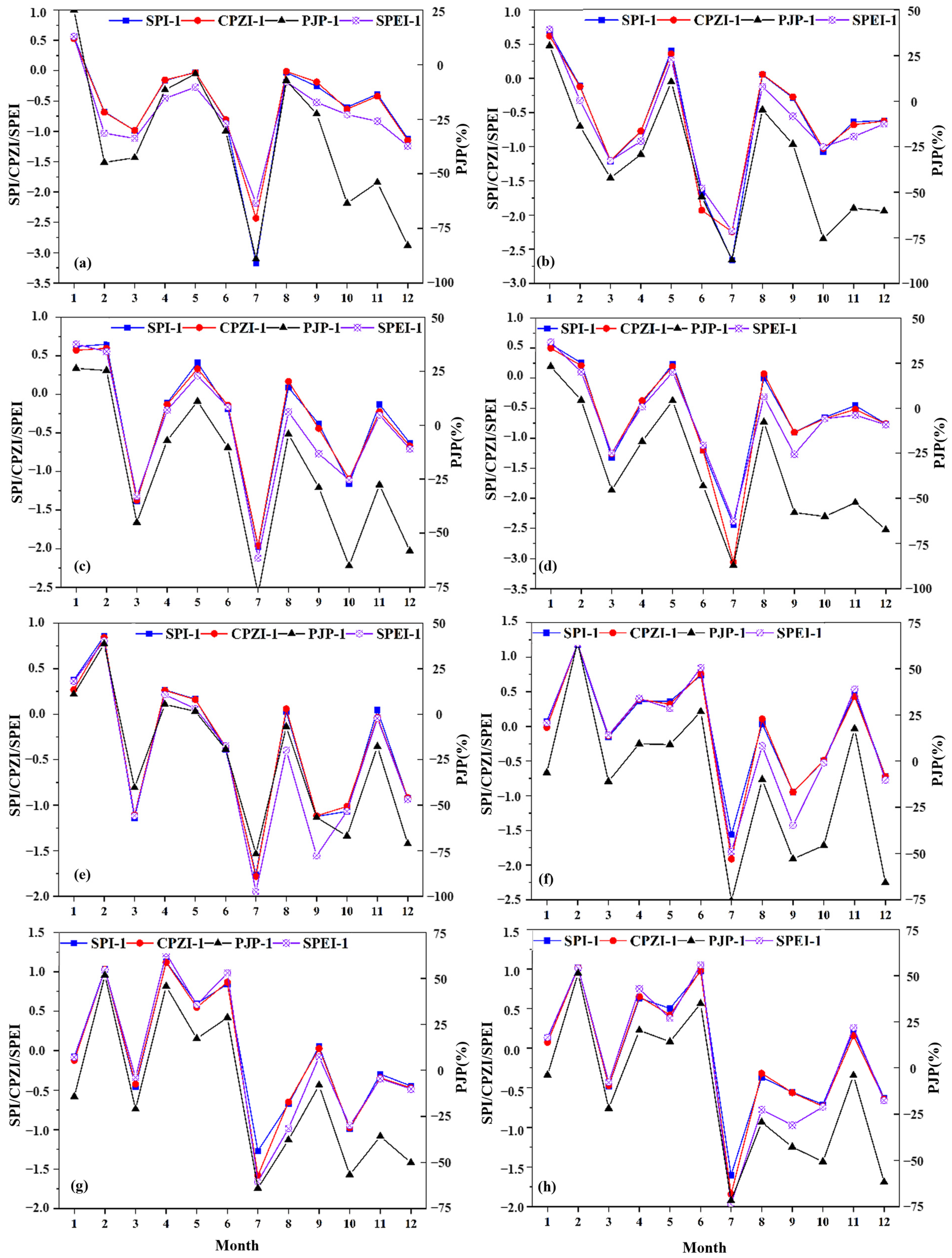
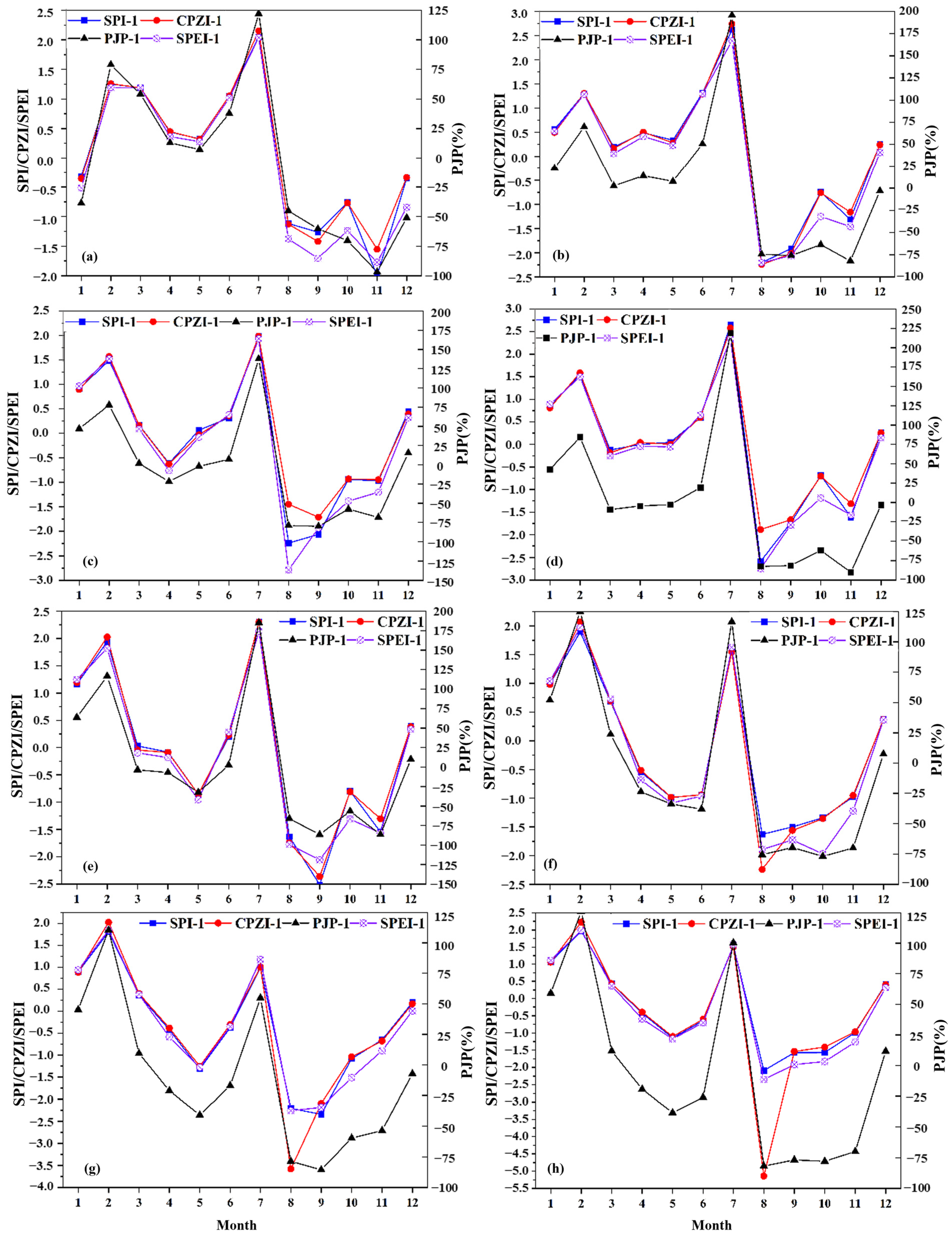

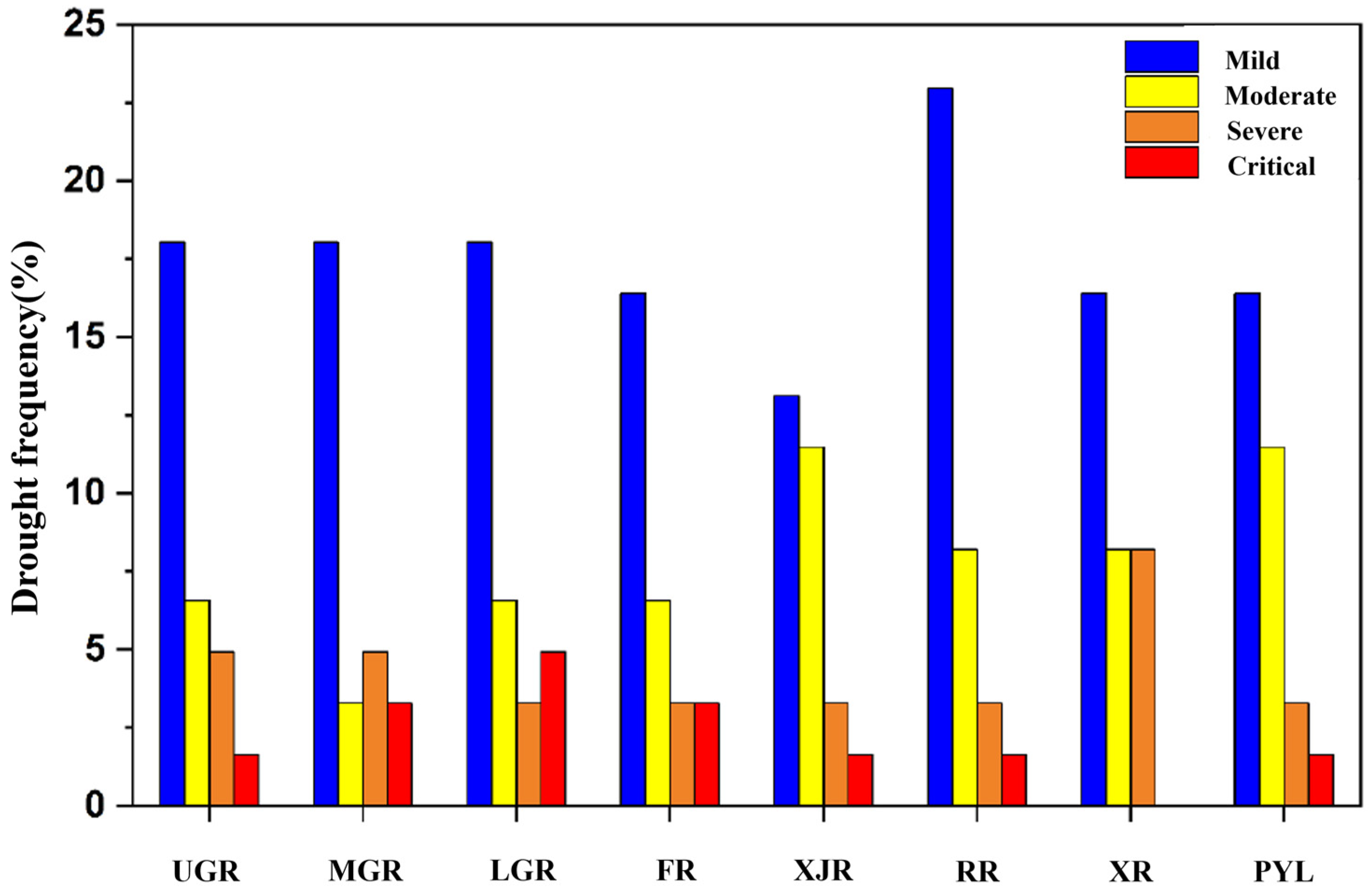
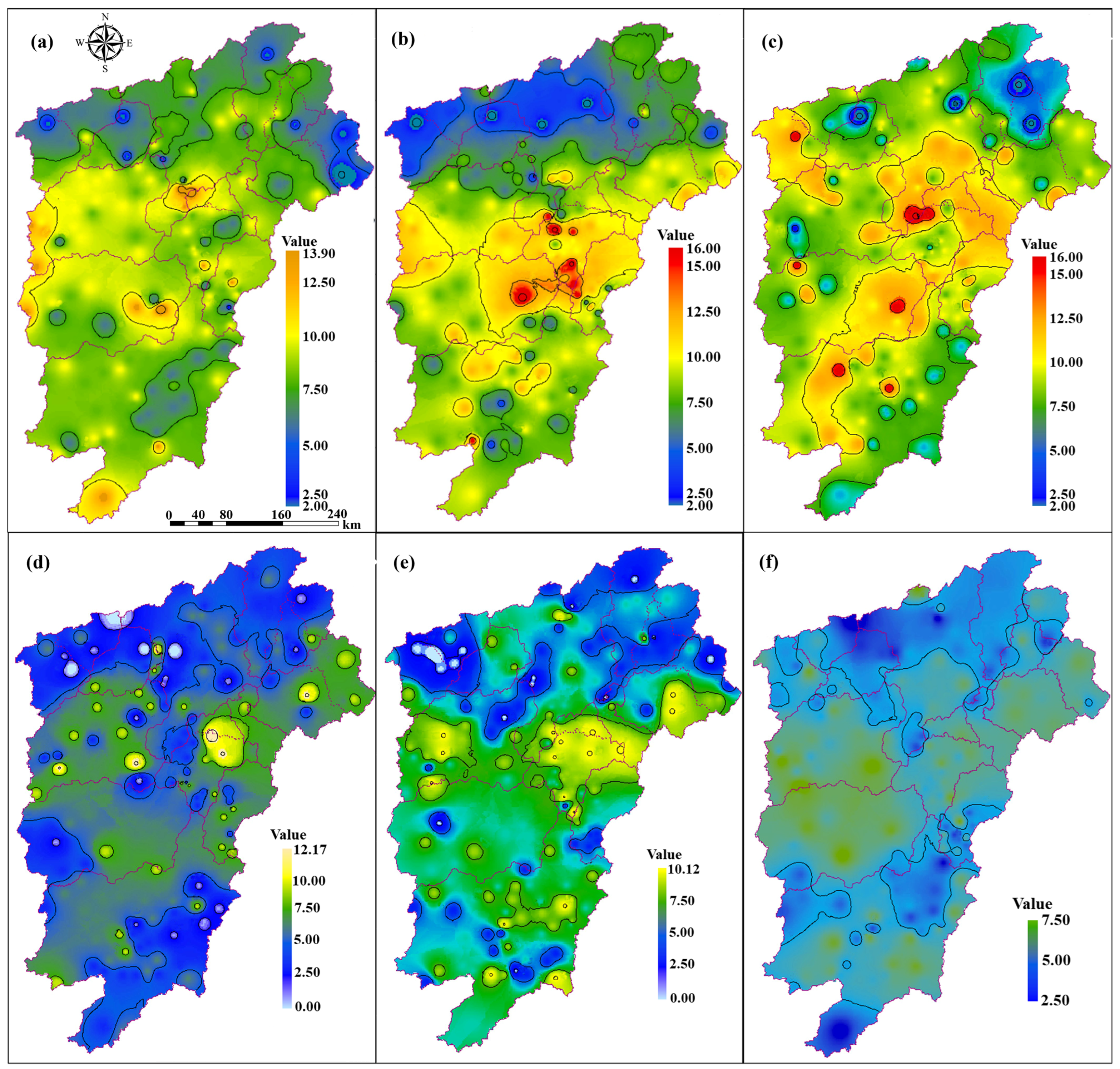



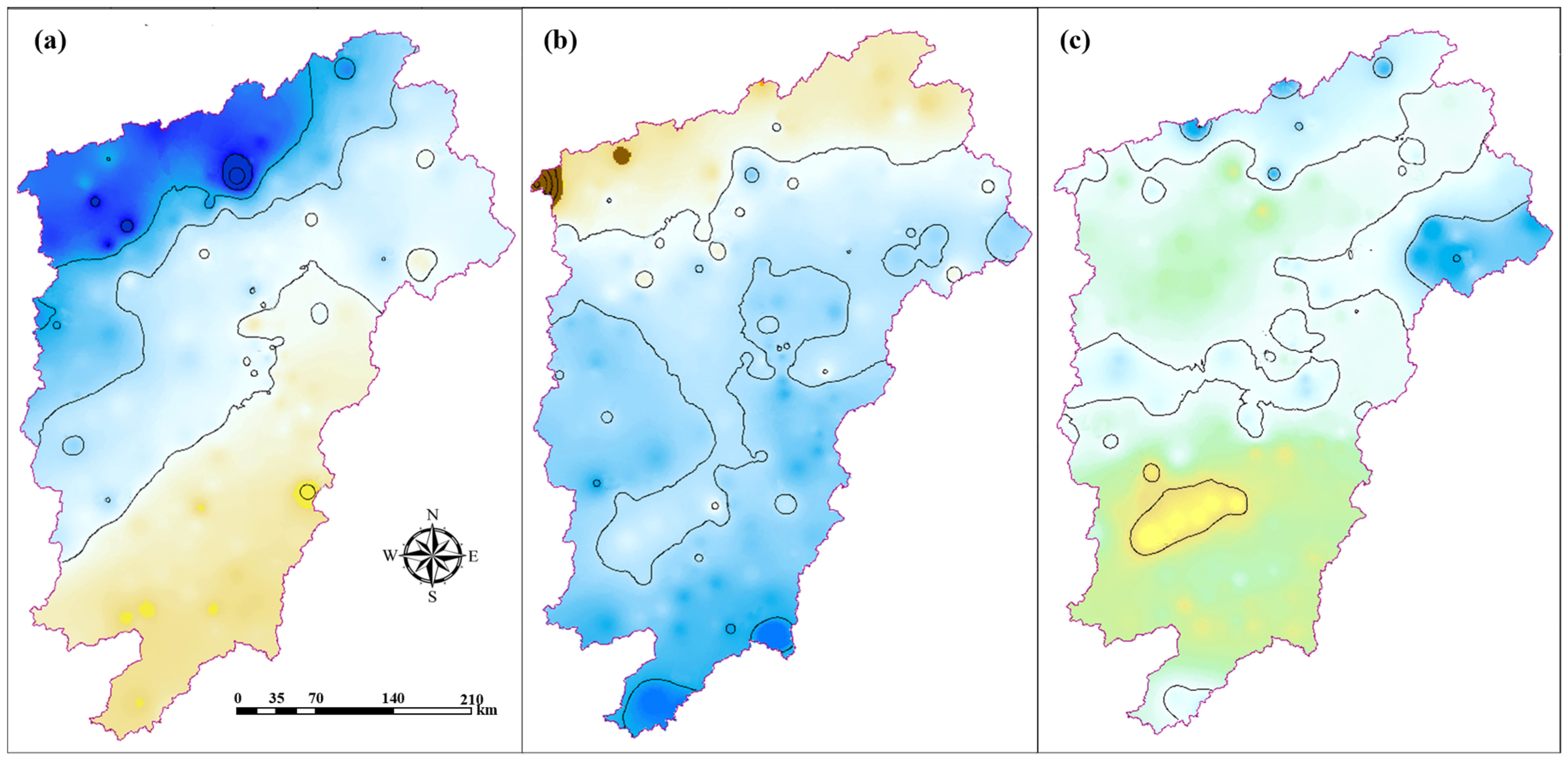
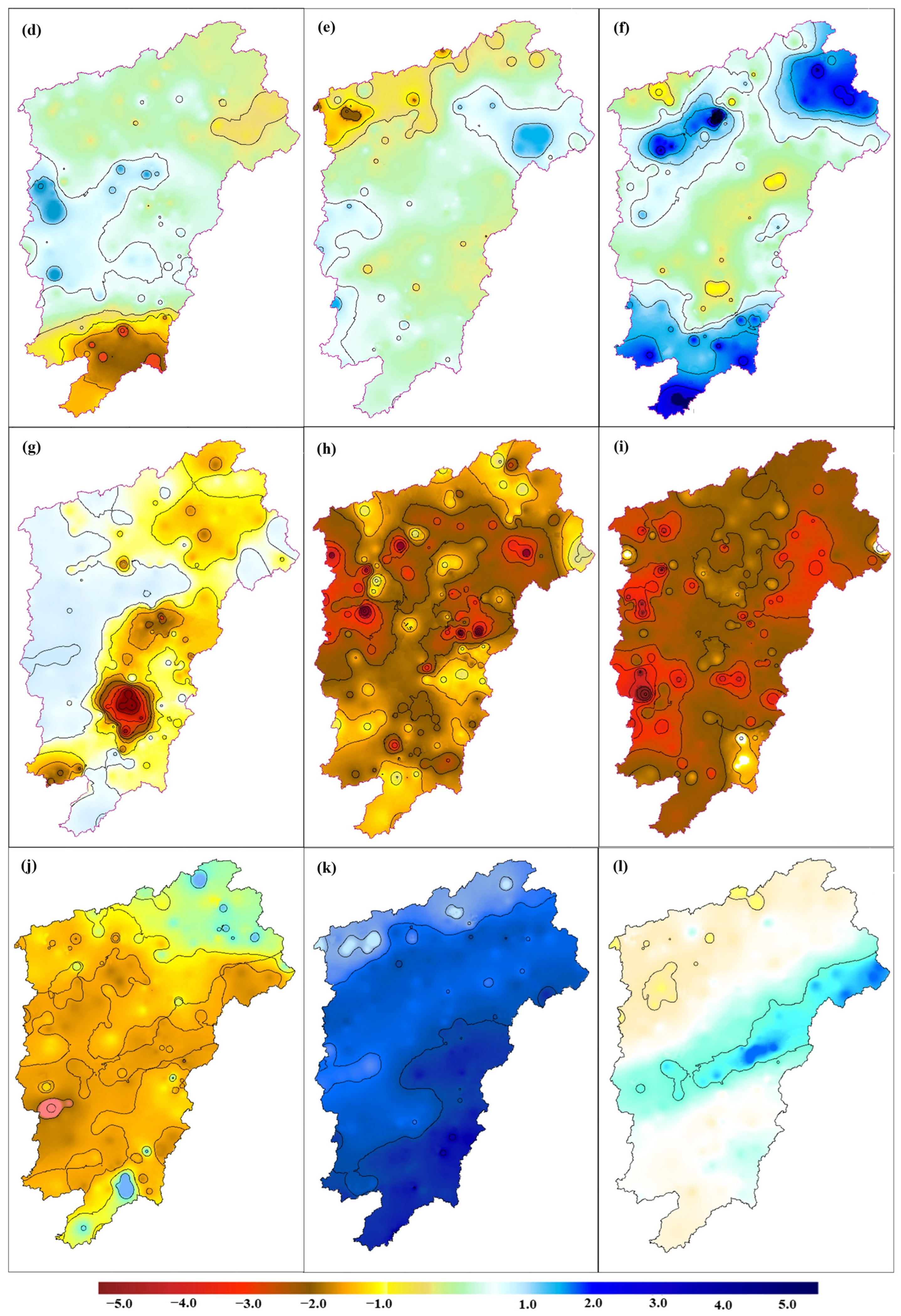
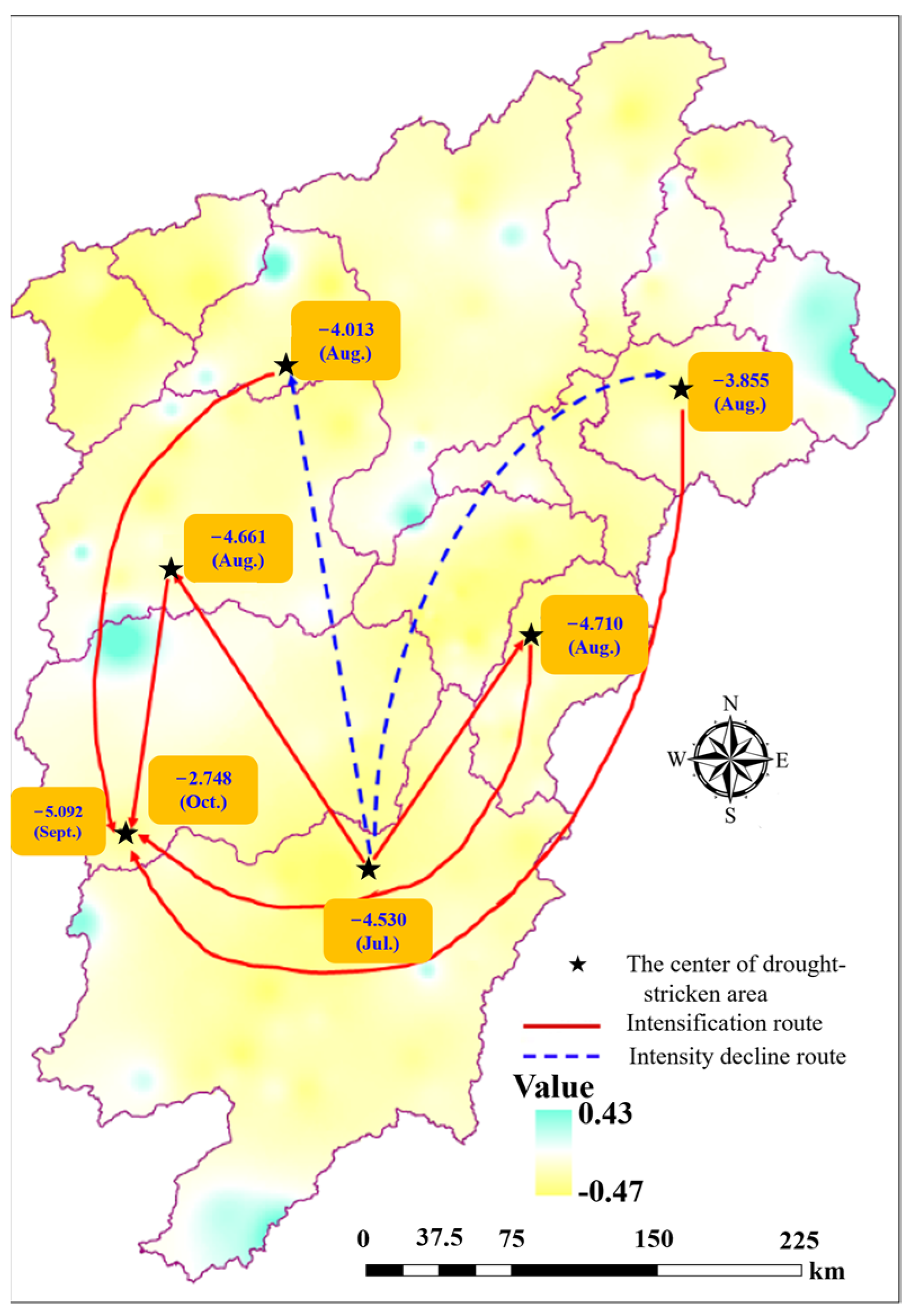

| Level | Type | PJP (Monthly Scale) | SPI/SPEI | CPZI |
|---|---|---|---|---|
| 1 | No drought | (−40, 0) | (−0.5, 0) | (−0.524, 0) |
| 2 | Mild drought | (−60, −40] | (−1.0, −0.5] | (−1.037, −0.524] |
| 3 | Moderate drought | (−80, −60] | (−1.5, −1.0] | (−1.645, −1.037] |
| 4 | Severe drought | (−95, −80] | (−2.0, −1.5] | (−1.96, −1.645] |
| 5 | Extreme drought | ≤−95 | ≤−2.0 | ≤−1.96 |
| Frequency (%) | Spring | Summer | Autumn | Winter | Annual | Monthly |
|---|---|---|---|---|---|---|
| 0–2.5 | 0.05 | 0.20 | 0.10 | 1.78 | 1.17 | - |
| 2.5–5.0 | 2.39 | 9.23 | 1.14 | 32.76 | 15.31 | 32.03 |
| 5.0–7.5 | 24.47 | 22.49 | 12.98 | 60.72 | 66.09 | 67.97 |
| 7.5–10.0 | 66.56 | 45.89 | 57.46 | 4.56 | 17.16 | - |
| 10.0–12.5 | 6.36 | 20.59 | 27.46 | 0.17 | 0.27 | - |
| 12.5–15.0 | 0.18 | 1.51 | 0.83 | - | - | - |
| 15.0–17.5 | - | 0.09 | 0.04 | - | - | - |
| Vulnerable area 1 | 6.54 | 22.19 | 28.33 | 0.17 | 0.27 | - |
| Month | Mild Drought | Moderate Drought | Severe Drought | Extreme Drought | Moderate Drought or Worse | Severe Drought or Worse |
|---|---|---|---|---|---|---|
| 1 | 0.09 | 0 | 0 | 0 | 0 | 0 |
| 2 | 0.10 | 0.07 | 0.07 | 0.01 | 0.15 | 0.08 |
| 3 | 2.76 | 0 | 0 | 0 | 0 | 0 |
| 4 | 6.47 | 4.12 | 5.51 | 0.62 | 10.25 | 6.13 |
| 5 | 8.72 | 2.57 | 0.31 | 0 | 2.89 | 0.32 |
| 6 | 1.76 | 0.06 | 0 | 0 | 0.06 | 0 |
| 7 | 32.78 | 21.22 | 5.09 | 3.80 | 30.11 | 8.89 |
| 8 | 1.97 | 16.99 | 41.41 | 39.43 | 97.83 | 80.84 |
| 9 | 0.06 | 1.67 | 16.91 | 81.36 | 99.93 | 98.26 |
| 10 | 19.82 | 41.65 | 36.47 | 0.84 | 78.12 | 37.31 |
| 11 | 0 | 0 | 0 | 0 | 0 | 0 |
| 12 | 2.90 | 0 | 0 | 0 | 0 | 0 |
Disclaimer/Publisher’s Note: The statements, opinions and data contained in all publications are solely those of the individual author(s) and contributor(s) and not of MDPI and/or the editor(s). MDPI and/or the editor(s) disclaim responsibility for any injury to people or property resulting from any ideas, methods, instructions or products referred to in the content. |
© 2024 by the authors. Licensee MDPI, Basel, Switzerland. This article is an open access article distributed under the terms and conditions of the Creative Commons Attribution (CC BY) license (https://creativecommons.org/licenses/by/4.0/).
Share and Cite
Gui, Z.; Qi, H.; Gui, F.; Zheng, B.; Wang, S.; Bai, H. The Applicability of the Drought Index and Analysis of Spatiotemporal Evolution Mechanisms of Drought in the Poyang Lake Basin. Water 2024, 16, 766. https://doi.org/10.3390/w16050766
Gui Z, Qi H, Gui F, Zheng B, Wang S, Bai H. The Applicability of the Drought Index and Analysis of Spatiotemporal Evolution Mechanisms of Drought in the Poyang Lake Basin. Water. 2024; 16(5):766. https://doi.org/10.3390/w16050766
Chicago/Turabian StyleGui, Zihan, Heshuai Qi, Faliang Gui, Baoxian Zheng, Shiwu Wang, and Hua Bai. 2024. "The Applicability of the Drought Index and Analysis of Spatiotemporal Evolution Mechanisms of Drought in the Poyang Lake Basin" Water 16, no. 5: 766. https://doi.org/10.3390/w16050766





